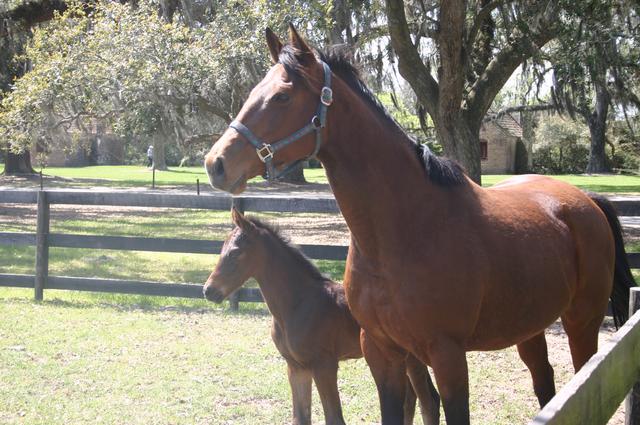 |
Quick Search |
 |
|
|
|
|
|
| Handling A New Foal |

|
If you are among those celebrating new arrivals this spring, you may be wondering
how to handle and begin training your new foal. It's never too early to start
working with a foal, and the more time you can spend with him, the more gentle
and easy to handle he will become. Lessons learned early on will last a lifetime.
Imprint training takes place as soon as the foal is born, but don't worry if you
missed out on that. You can still begin with the basics on an older foal.
Start by touching him all over, and try to do so without restraining him or
cornering him. Foals are naturally curious, and if you have the mare tied or
eating happily nearby, chances are the foal's instincts will make him come to
you. Babies love to be scratched, petted, and rubbed, and will learn to come
to you begging for you to fix that itch they can't reach.
Understand that a foal's instincts will cause him to treat you like another horse.
Foals easily become "nippy" and ornery when they get comfortable with a person.
Pay close attention to his demeanor and attitude, and be ready to correct him if
he starts to exert dominance. What seems like cute little tricks or nibbling at
you now will result in a pushy, ill-mannered, and even dangerous horse later on
if you don't set the foundation for respect. If your foal nips or nibbles at you,
quickly and firmly push his head or neck away from you. Mares do not tolerate
nips or kicks from their foals, and will lay their ears back and swing their heads
sharply at a foal to tell him he has crossed the line of what is acceptable behavior.
You need to do the same thing. Establish your personal space with a foal and
don't overlook little things you should correct.
Foals can learn basic pressure cues, such as moving over when you push gently on
a hip or shoulder. Working with a lead rope is a good idea, to get the foal used
to the feel of a rope and halter. You can also ask him to lift his feet. Start
by petting his legs all the way down, and holding onto his hoof. Stay out of
reach if he tries to kick. Then lift the hoof, just for a moment, and set it
back down carefully. Do not let him pull the hoof away from you, once you have
lifted it off the ground. It is important to set it down before letting go, as
this will teach the foal to accept your control of his hoof.
To begin training a foal to lead, work first of all without a halter or rope.
Start on the foal's left side, close against the foal, with one arm around the
neck, and an arm and elbow over the foal's back. Move with the foal, and use your
arm on the foal's ribs or hip to teach a "move forward" cue. Your body and arm
under the neck will help direct them right or left, step by step. Then switch
to the other side of the foal and repeat. In essence, you are teaching the foal
to follow you like he follows his mother, only adding the "move forward" cue.
It won't take long at all before you can direct the foal wherever you like.
Then add the halter and lead rope, and keep the same basic position and cues,
only add a little direction with the halter and the baby will learn to lead
quickly and without a lot of stress or confusion.
As with any type of learning, practice makes perfect. Patient and gentle handling
will help a foal form a good relationship with you and will prepare him to accept
further training in the future. The best horses are the ones someone invested
a lot of time into, and your foal will gain value as a horse if you take the
time to start him out right.
More Horse Articles
|
|
|

